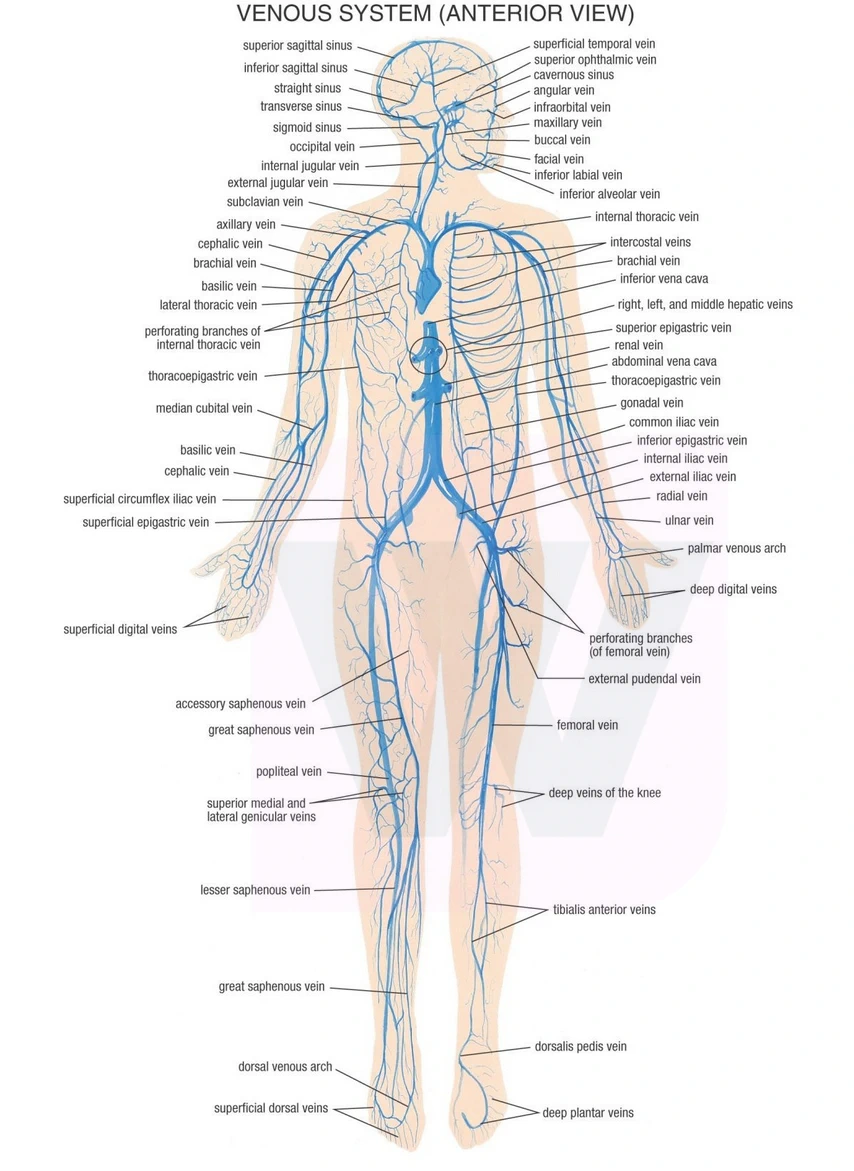Veins of the Human Body

The main function of veins is to transport blood, which is poor in oxygen and full of waste, from the capillaries to the heart. The vessels that carry blood away from the heart are called arteries.
Therefore, note that blood vessels are classified as: arteries, veins and blood capillaries. They differ from each other both in the function they perform and in the thickness of their walls.
Anatomy of the Veins of the Human Body
Veins are cylindrical tubes formed by venous valves that prevent the reverse flow of blood.
They have the ability to contract and expand their size according to the amount of blood available, which is why they serve as a reservoir.
To control blood flow correctly, veins have valves that help maintain blood pressure and prevent blood from pooling.
The vein wall is formed by three layers, which are:
- Inner tunic:formed by connective tissue;
- Middle tunica:this is the most resistant layer and is formed by muscle tissue and elastic tissue;
- Tunica externa:also known as tunica adventitia, it is formed by flexible connective tissue.
Main Veins of the Human Body
Below, you can find out about the main veins that are part of the human body.
Pulmonary vein
These veins are responsible for carrying oxygen-rich blood from the lungs to the left atrium of the heart.
There are four pulmonary veins, two for each lung: an upper right and an lower one, as well as an upper and lower left one.
vena cava
The vena cava is considered the main vein in the body, as it is responsible for carrying blood from the head, upper and lower limbs and abdomen back to the heart. Therefore, it is divided into the superior vena cava and the inferior vena cava.
They are also known to be part of the systemic circulation (or grand circulation).
The vena cava is used as part of the treatment of thrombosis in people who are at risk of the disease.
portal vein
The portal vein is part of the circulatory system and plays an extremely important role, as it is through it that blood from the intestine, stomach and esophagus passes to reach the liver.
Thus, we have the portal vein system, which is then formed by several veins that form numerous branches inside the liver.
Femoral vein
The femoral vein is located in the lower limbs and accompanies the entire femoral artery. They are divided into two groups: deep veins, which accompany the main arteries, and superficial veins, which are located in the subcutaneous tissue.
This vein runs throughout the leg and works together with other veins to promote circulation and drainage of blood from the muscles. The blood flow from the leg passes through the femoral vein.
Iliac veins
The iliac veins are located in the abdomen and accompany the common iliac artery.
The iliac veins are classified into two groups (internal and external) and, when together, form the inferior vena cava.
A common anomaly that occurs in this vein is May-Thurner syndrome, which consists of compression of the vein by the artery. After diagnosis, a stent (a type of mesh) can be inserted to decompress and allow correct blood flow.
Jugular vein
The jugular vein is located in the neck and its function is to transport venous blood (rich in carbon dioxide and poor in oxygen) from the skull to the parts of the body.
In the human body, two pairs are found, one internal and one external, on each side of the neck.
saphenous vein
The saphenous veins are the main veins of the venous system, as they are responsible for transporting blood from the upper limbs to the lower limbs of the body.
They are located in the lower limbs.
Diseases caused by lack of circulation in the veins
Some diseases may be related to veins and circulation. See some examples below.
Varicose veins
Varicose veins are dilated veins that appear in the lower limbs, causing pain, swelling, deformities and loss of sensitivity. Although more common in women, men also have varicose veins.
Varicose ulcers are characterized by the accumulation of venous blood, lack of oxygenation, increased pressure and accumulation of toxins.
Phlebitis
Phlebitis, also called venous thrombosis, is characterized by inflammation that occurs in the vein walls, causing swelling, pain and a feeling of heaviness in the legs.
It is worth noting that there are two types of phlebitis: superficial phlebitis, characterized by visible veins; and deep phlebitis, marked by deeper veins.
Interesting facts about the veins of the human body
- Veins, arteries and capillaries cover 97 thousand kilometers throughout our body.
- The study of veins and blood vessel treatments is called Phlebology.
- Veins have thinner walls than arteries as they are subject to less pressure.
- The diameter of the veins can vary, that is, some are less than 1 mm (thin veins), and others can reach up to 10 mm (thick veins).
Read also about:
- Human body systems
- Hypertension
- Hypotension
- Curiosities about the human body